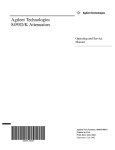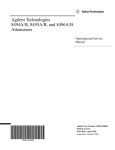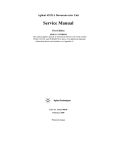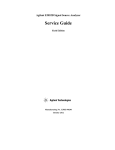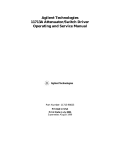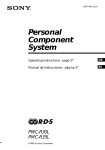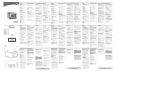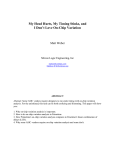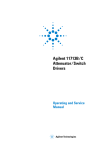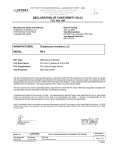Download Agilent Technologies 8496G Service manual
Transcript
Agilent Technologies 8494/95/96G/H Attenuators Operating and Service Manual Agilent Part Number: 08495-90025 Printed in USA Print Date: August 2004 Supersedes: July 2002 Notice The information contained in this document is subject to change without notice. Agilent Technologies makes no warranty of any kind with regard to this material, including, but not limited to, the implied warranties of merchantability and fitness for a particular purpose. Agilent Technologies shall not be liable for errors contained herein or for incidental or consequential damages in connection with the furnishing, performance, or use of this material. Agilent Technologies assumes no responsibility for the use or reliability of its software on equipment that is not furnished by Agilent Technologies. This document contains proprietary information which is protected by copyright. All rights are reserved. No part of this document may be photocopied, reproduced, or translated to another language without prior written consent of Agilent Technologies. RESTRICTED RIGHTS LEGEND Use, duplication, or disclosure by the U.S. Government is subject to restrictions as set forth in subparagraph (c)(1)(ii) of the Rights in Technical Data and Computer Software clause at DFARS 252.227-7013 for DOD agencies, and subparagraphs (c)(1) and (c)(2) of the Commercial Computer Software Restricted Rights clause at FAR 52.227-19 for other agencies. Agilent Technologies, Inc. 1400 Fountaingrove Parkway Santa Rosa, CA 95403-1799, U.S.A. © Copyright 2000–2002, 2004 Agilent Technologies, Inc. ii 8494/95/96G/H Operating And Service Manual What You’ll Find in This Manual… • • • • • • Overview, page 1 Specifications, page 6 Installation, page 10 Operating Instructions, page 12 Replaceable Parts, page 15 Service, page 16 8494/95/96G/H Operating And Service Manual iii Warranty Custom systems are warranted by contractual agreement between Agilent Technologies and the customer. Certification Agilent Technologies, Inc., certifies that this product met its published specifications at the time of shipment from the factory. Agilent Technologies further certifies that its calibration measurements are traceable to the United States National Institute of Standards and Technology (NIST, formerly NBS), to the extent allowed by the Institute’s calibration facility, and to the calibration facilities of other International Standards Organization members. Documentation Warranty THE MATERIAL CONTAINED IN THIS DOCUMENT IS PROVIDED "AS IS," AND IS SUBJECT TO BEING CHANGED, WITHOUT NOTICE, IN FUTURE EDITIONS. FURTHER, TO THE MAXIMUM EXTENT PERMITTED BY APPLICABLE LAW, AGILENT DISCLAIMS ALL WARRANTIES, EITHER EXPRESS OR IMPLIED WITH REGARD TO THIS MANUAL AND ANY INFORMATION CONTAINED HEREIN, INCLUDING BUT NOT LIMITED TO THE IMPLIED WARRANTIES OF MERCHANTABILITY AND FITNESS FOR A PARTICULAR PURPOSE. AGILENT SHALL NOT BE LIABLE FOR ERRORS OR FOR INCIDENTAL OR CONSEQUENTIAL DAMAGES IN CONNECTION WITH THE FURNISHING, USE, OR PERFORMANCE OF THIS DOCUMENT OR ANY INFORMATION CONTAINED HEREIN. SHOULD AGILENT AND THE USER HAVE A SEPARATE WRITTEN AGREEMENT WITH WARRANTY TERMS COVERING THE MATERIAL IN THIS DOCUMENT THAT CONFLICT WITH THESE TERMS, THE WARRANTY TERMS IN THE SEPARATE AGREEMENT WILL CONTROL. iv 8494/95/96G/H Operating And Service Manual Service and Support Product maintenance agreements and other customer assistance agreements are available for Agilent Technologies products. Any adjustment, maintenance, or repair of this product must be performed by qualified personnel. Contact your customer engineer through your local Agilent Technologies Service Center. You can find a list of local service representatives on the Web at: http://www.agilent.com/find/assist Click on “Contact Us” and select your country. Safety and Regulatory Information Review this product and related documentation to familiarize yourself with safety markings and instructions before you operate the instrument. This product has been designed and tested in accordance with international standards. WARNING The WARNING notice denotes a hazard. It calls attention to a procedure, practice, or the like, that, if not correctly performed or adhered to, could result in personal injury. Do not proceed beyond a WARNING notice until the indicated conditions are fully understood and met. CAUTION The CAUTION notice denotes a hazard. It calls attention to an operating procedure, practice, or the like, which, if not correctly performed or adhered to, could result in damage to the product or loss of important data. Do not proceed beyond a CAUTION notice until the indicated conditions are fully understood and met. 8494/95/96G/H Operating And Service Manual v Instrument Markings ! When you see this symbol on your instrument, you should refer to the instrument’s instruction manual for important information. This symbol indicates hazardous voltages. The laser radiation symbol is marked on products that have a laser output. This symbol indicates that the instrument requires alternating current (ac) input. The CE mark is a registered trademark of the European Community. If it is accompanied by a year, it indicates the year the design was proven. The CSA mark is a registered trademark of the Canadian Standards Association. 1SM1-A This text indicates that the instrument is an Industrial Scientific and Medical Group 1 Class A product (CISPER 11, Clause 4). This ISM device complies with Canadian ICES-001. Cet appareil ISM est conforme a la norme NMB du Canada. This symbol indicates that the power line switch is ON. This symbol indicates that the power line switch is OFF or in STANDBY position. Safety Earth Ground This is a Safety Class I product (provided with a protective earthing terminal). An uninterruptible safety earth ground must be provided from the main power source to the product input wiring terminals, power cord, or supplied power cord set. Whenever it is likely that the protection has been impaired, the product must be made inoperative and secured against any unintended operation. Before Applying Power Verify that the product is configured to match the available main power source as described in the input power configuration instructions in this manual. If this product is to be powered by autotransformer, make sure the common terminal is connected to the neutral (grounded) side of the ac power supply. vi 8494/95/96G/H Operating And Service Manual Overview This manual contains operating instructions for the Agilent 8494G/H, 8495G/H, and 8496G/H attenuators. Included in the manual is information required to install and test these attenuators. Specification Instruments Covered by Manual Instrument specifications are indicated in Specifications, page 6. These specifications are the performance standards or limits against which the instruments may be tested. The instruments covered by this manual have a two-part serial number. The first four digits and letter comprise the serial number prefix. The last five digits form the sequential suffix that is unique to each instrument. The contents of this manual apply to instruments with serial prefixes 2544A and above. An instrument manufactured after the printing of this manual may have a serial prefix that is not listed above. This unlisted serial prefix indicates that the instrument is different from those documented in this manual. Description The 8494G/H, 8495G/H, and 8496G/H are 50-ohm coaxial programmable step-attenuators. Each attenuator is composed of three or four attenuator sections connected in cascade. Each section consists of a precision, thin-film attenuator card, a lossless thru-line, and a ganged pair of solenoid-actuated slab line transmission lines. The slab lines are flexed by the solenoid plungers to make contact with either the attenuator card or the thru-line. The slab line contacts are gold plated leaf springs which ensure long life and extremely high repeatability. 8494/95/96G/H Operating And Service Manual 1 Overview NOTE Solenoid (K4) and associated circuitry are not available in models 8495G and 8495H. Figure 1 Typical Four Section Attenuator Schematic Diagram Table 1 and Table 2 on page 3 and Table 3 on page 4 show the typical switching arrangement to increase the amount of attenuation in an 8494G/H, 8495G/H, or 8496G/H in a linear manner. To ensure specified performance, it is recommended that the attenuator sections that are shown in the following tables be used. With the attenuator programmed for 0 dB attenuation, the resultant attenuation is the insertion loss (residual attenuation). The 8494G/H has a minimum selectable step of 1 dB, while the 8495G/H and 8496G/H have a minimum selectable step of 10 dB. The accuracy of the attenuators is within the limits given in Specifications, page 6. • The 8494G/H are four-section attenuators with a maximum attenuation of 11 dB. • The 8495G/H are three-section attenuators with a maximum attenuation of 70 dB. • The 8496G/H are four-section attenuators with a maximum attenuation of 110 dB. 2 8494/95/96G/H Operating And Service Manual Overview Table 1 8494G/H Attenuator Switching Order 8494G/H Attenuator Sections Atten (dB) 1 1 dB 2 2 dB 3 4 dB 4 4 dB 0 1 X 2 X 3 X X 4 X 5 X 6 7 X X X X X X 8 9 X X X X X X X X X X 10 11 Table 2 X X 8495G/H Attenuator Switching Order 8495G/H Attenuator Sections Atten (dB) 1 10 dB 2 20 dB 3 40 dB 0 10 X 20 30 X X X 40 50 X X 60 70 X X X X X X 8494/95/96G/H Operating And Service Manual 3 Overview Table 3 8496G/H Attenuator Switching Order 8496G/H Attenuator Sections Atten (dB) 1 10 dB 2 20 dB 3 40 dB 4 40 dB 0 10 X 20 30 X X X 40 50 X X 60 70 X X X X X X 80 90 X X X X X X X X X X 100 110 X X Each solenoid requires a drive of 20 to 30 V with a switching current of approximately 125 mA* at 24 V dc per section. The solenoid switching time is less than 20 milliseconds including settling time. Once switched, the solenoid plungers are held in place by permanent magnets and the solenoid plungers automatically disconnect the selected coil drive and connect the opposite coil drive (see Figure 1 and Figure 2). This simplifies the coil driver circuit design and reduces the amount of heat dissipated by the solenoid coils since the solenoid coils are energized only for the 20 milliseconds switching time. * For serial number prefixes below 1722A, change 125 mA to 110 mA. 4 8494/95/96G/H Operating And Service Manual Overview Figure 2 CAUTION Instrument Options Typical Solenoid Coil Driver Circuits Do not exceed the RF power rating of 1 W average or 100 W peak with a maximum pulse width of 10 µs. Do not connect an attenuator RF input or output connector to greater the ±7 Vdc. If the attenuator must be connected to a device with a potential greater than ±7 Vdc, use a blocking capacitor. Each instrument is specified with an option number which denotes the configuration of the input and output connectors. Option Connector Description 001 Both connectors type-N female 002 Both connectors SMA female 0031 Both connectors 7 mm 1. Option 003 is not available on the 8495G. 8494/95/96G/H Operating And Service Manual 5 Specifications Specifications Frequency Range and Attenuation Attenuation Accuracy 8494G/H 8495G/H 8496G/H Attenuation Selection (dB) Instrument Frequency Range Attenuation 8494G dc to 4 GHz 0 dB to 11 dB in 1 dB steps 8494H dc to 18 GHz 0 dB to 11 dB in 1 dB steps 8495G dc to 4 GHz 0 dB to 70 dB in 10 dB steps 8495H dc to 18 GHz 0 dB to 70 dB in 10 dB steps 8496G dc to 4 GHz 0 dB to 110 dB in 10 dB steps 8496H dc to 18 GHz 0 dB to 110 dB in 10 dB steps (±dB): (Referenced from 0 dB) 8494G 8494H 8495G 8495H 8496G 8496H dc–4 GHz dc–12.4 GHz 12.4–18 GHz dc–4 GHz dc–12.4 GHz 12.4–18 GHz dc–4 GHz dc–12.4 GHz 12.4–18 GHz 1 10 0.2 0.3 0.7 0.2 0.5 0.6 0.2 0.5 0.6 2 20 0.2 0.3 0.7 0.4 0.7 0.8 0.4 0.7 0.8 3 30 0.3 0.4 0.7 0.5 0.9 1.2 0.5 0.9 1.2 4 40 0.3 0.4 0.7 0.7 1.2 1.6 0.7 1.2 1.6 5 50 0.3 0.5 0.7 0.8 1.5 2.0 0.8 1.5 2.0 6 60 0.3 0.5 0.8 1.0 1.8 2.4 1.0 1.8 2.4 7 70 0.4 0.6 0.8 1.2 2.1 2.8 1.2 2.1 2.8 8 80 0.4 0.6 0.8 - - - 1.3 2.4 3.2 9 90 0.4 0.6 0.8 - - - 1.5 2.7 3.6 10 100 0.4 0.6 0.9 - - - 1.6 3.0 4.0 11 110 0.5 0.7 0.9 - - - 1.8 3.3 4.4 6 8494/95/96G/H Operating And Service Manual Specifications Maximum SWR Instrument Frequency Range (GHz) Maximum SWR 8495G dc to 4 1.35 8495H dc to 8 8 to 12.4 12.4 to 18 1.35 1.5 1.7 8494G, 8496G dc to 4 1.5 8494H, 8496H dc to 8 8 to 12.4 12.4 to 18 1.5 1.6 1.9 Maximum Residual Attenuation Attenuation Repeatability RF Power Handling Capability Instrument Maximum Residual Attenuation 8494G, 8494H 0.6 dB + 0.09 dB/GHz 8495G, 8495H 0.4 dB + 0.07 dB/GHz 8496G, 8496H 0.6 d8 + 0.09 dB/GHz ±0.01 dB typical after 5 million cycles 1 W average, 100 W peak with maximum pulse width of 10 microseconds (all models) Solenoid Drive Solenoids Drive Coil Voltage Switching Current All models (approximately) 20 to 30 Vdc 125 mA1 at 24V (190Ω, 65mH) 1. For serial number prefixes below 1722S, change 125mA to 110mA. 8494/95/96G/H Operating And Service Manual 7 Specifications Solenoid Cable Connector Section Refer also to Figure 3. Section 1 Section 2 Section 3 Section 4 Power Solenoid Coil Thru-Line Atten Card Thru-Line Atten Card Thru-Line Atten Card Thru-Line Atten Card V+ Cable Wire Color Code1 PUR YEL BLK GRN ORN BLU BRN WHT RED Connector Plug Pin Number 2 5 6 7 8 9 10 11 12 1 8494G/H 0dB 1dB 0dB 2dB 0dB 4dB 0dB 4dB – 8495G/H 0dB 10dB 0dB 20dB 0dB 40dB – – – 8496G/H 0dB 10dB 0dB 20dB 0dB 40dB 0dB 40dB – Option 016 13 2 11 5 3 9 4 10 6 Flat Pack Plug Pin Number3 1. Five-foot cable and mating plug assembly provided. 2. Pin 1 Common solenoid drive (+24 Vdc). 3. Pin 6 is common for all coils. Pins 1, 7, 8, 12 and 14 are not used. Figure 3 Solenoid Cable Pin Configuration 8 8494/95/96G/H Operating And Service Manual Specifications Minimum Life Switching speed Environment Limits >5 million cycles per section Maximum 20 milliseconds including settling time. The instrument should be stored in a clean, dry environment. The following environmental limits apply to storage and shipment, and operation. Characteristic Storage and Shipping Value Operating Value Temperature –40 to +75 °C 0 to +55 °C Humidity < 95% relative < 95% relative Altitude < 7600 m (25000 ft) < 4600 m (15000 ft) Physical Characteristics Instrument Dimensions 1 (depth x width x height) Weight 2 8494G/H 8496G/H 6.25 in x 2.875 in x 1.6875 in 159 mm x 73 mm x 43 mm 16 oz 8495G/H 5.125 in x 2.875 in x 1.6875 in 130 mm x 73 mm x 43 mm 12 oz 454 g 340 g 1. Dimensions are for general information only. If dimensions are required for building special enclosures, contact your Agilent field engineer. 2. Weight and width of the instrument varies with the option selected due to the type of connectors. 8494/95/96G/H Operating And Service Manual 9 Installation Installation Initial Inspection Inspect the shipping container for damage. If the shipping container or cushioning material is damaged, it should be kept until the contents of the shipment have been checked for completeness and the instrument has been checked mechanically and electrically. A procedure for checking electrical performance is given under “Operator’s Check” on page 12 (also see “Performance Tests” on page 14). If the contents of the shipment are incomplete, if there is mechanical damage or defect, or if the instrument does not pass the electrical performance test, notify the nearest Agilent Technologies office. If the shipping container is damaged, or the cushioning material shows signs of stress, notify the carrier as well as the Agilent office. Keep the shipping materials for the carrier's inspection. The office will arrange for repair or replacement without waiting for claim settlement. NOTE Containers and materials identical to those used in factory packaging are available through Agilent Technologies offices. If the instrument is being returned to Agilent for servicing, attach a tag indicating the type of service required, return address, model number, and full serial number. Also, mark the container FRAGILE to assure careful handling. In any correspondence, refer to the instrument by model number and full serial number. Mating Connectors Mating RF connectors used with the Option 001 must be type-N male connectors, which comply with U.S. military standard MIL-C-39012 (See Figure 7 on page 19). For Option 002, male SMA connectors must be used. For Option 003, 7 mm mating connectors must be used (Figure 6 on page 18). The solenoid drive cable connector plug is a Viking Industries, Inc., part number TKP12-102-P-TS-100-AU (see Replaceable parts). The connector plug and contacts without the cable can be ordered from a Viking distributor. When ordering the complete cable assembly from Agilent, use the part number listed in Table 5, “Replaceable Parts,” on page 15. CAUTION When installing the instrument, make sure that the connectors do not support weight or bear torque. The preferred procedure is to set up all equipment in position before connecting the instrument. 10 8494/95/96G/H Operating And Service Manual Installation Installation Instructions The attenuators may be installed with or without the base. The base is removed by unscrewing the two fillister head screws from the bottom of the base. The attenuator may be mounted without the base by inserting two 4-40 screws into the screw holes in the bottom of the attenuator. Removing the base and mounting the attenuator does not affect the performance of the attenuator. The solenoid drive cable connector plug is connected to the attenuator by aligning the plug (Pl) with the jack (Jl) on the attenuator, and then pushing the plug over the jack. The plug is removed by grasping the ribbed sides of the plug and squeezing them together while pulling back until the plug clears the jack. 8494/95/96G/H Operating And Service Manual 11 Operating Instructions Operating Instructions CAUTION Do not apply RF power greater than 1 W average, or 100 W peak with a maximum pulse width of 10 microseconds. If these limits are exceeded, the attenuators may be damaged. CAUTION Do not ground both solenoid drive pins at the same time. This causes rapid cycling of the solenoid and could reduce the operating life of the attenuator. The rapid cycling may produce a buzzing sound from the attenuator. Either RF connector may be used as the input or output connector. Connect the solenoid drive cable to the solenoid drive connector (J1). By applying the proper voltage and grounds to the proper pins of J1, the attenuator will either increase or decrease the amount of attenuation as selected. Operator’s Check Description NOTE The Operator's Check is supplied to allow the operator to make a quick check of the instrument prior to use or if a failure is suspected. The attenuator is driven from a 50-ohm signal source at 1 kHz. The output level from the attenuator is detected by a narrow-bandwidth voltmeter. The attenuator and detector range switches are stepped together and the variations in level noted. This verifies that each attenuator section is being properly switched and checks the low-frequency accuracy of the attenuator. The SWR meter used in this check is calibrated for a square-law detector and therefore the range changes and errors (read in dB) are twice that indicated by the meter. Figure 4 Operator’s Check Setup 12 8494/95/96G/H Operating And Service Manual Operating Instructions Procedure 1. Connect equipment as shown in Figure 4 on page 12 with the attenuator set to 0 dB attenuation. 2. Set the test oscillator to 0.3 Vrms at 1 kHz. 3. Set SWR meter range to 2 dB (expanded) [or for the 8494G/H to 10 dB (expanded)] and adjust its bandwidth to center of adjustment range. Fine tune oscillator frequency to obtain maximum meter indication. 4. Set attenuator and SWR meter range switch as listed in Table 4 and verify that SWR meter indicates within limits shown. Table 4 SWR Meter Range (dB) Attenuator and SWR Settings Attenuation (dB) Meter Indication (dB) Minimum Actual Maximum 8494G/H 8495G/H 8496G/H 8494G/H 8495G/H 8496G/H 8494G/H 8495G/H 8496G/H 8494G/H 8495G/H 8496G/H 8494G/H 8495G/H 8496G/H 10 2 0 0 0 - - Set to 0.0 Set to 0.5 - - 10 6 1 10 10 0.40 1.40 - - 0.60 1.60 10 12 2 20 20 0.90 0.30 - - 1.10 0.70 10 16 3 30 30 1.35 1.25 - - 1.65 1.75 10 1 22 4 40 40 1.85 0.15 - - 2.15 0.85 12 26 5 50 50 0.35 1.10 - - 0.65 1.90 12 32 6 60 60 0.85 0.00 - - 1.15 1.00 12 36 1 7 70 70 1.30 0.90 - - 1.70 2.10 12 1 42 1 8 - 80 1.80 –0.15 - - 2.20 1.15 14 46 1 9 - 90 0.30 0.75 - - 0.70 2.25 14 52 1 10 - 100 0.80 –0.30 - - 1.20 1.30 14 56 1 11 - 110 1.75 0.60 - - 1.75 2.40 1. Adjust range by 2 dB, if needed, to obtain a on-scale indication. 8494/95/96G/H Operating And Service Manual 13 Operating Instructions Performance Tests The instrument can be tested to the accuracy of the “Specifications” on page 6, with an automatic network analyzer or equivalent equipment of suitable accuracy. If an automatic network analyzer is available, test the instrument using the procedures in the analyzer's operating manual. Refer to the Agilent 11713A Attenuator/Switch Driver Operating and Service Manual for programming instructions. Adjustments The attenuators have no internal adjustments and should not be opened. If defective, return the attenuator to the nearest Agilent Technologies office for repair. 14 8494/95/96G/H Operating And Service Manual Replaceable Parts Replaceable Parts Table 5 lists the replaceable parts which are the only parts that can be replaced without access to the interior of the instrument. If any parts not listed below need replacement, return the instrument to Agilent Technologies. To order a part listed in the replaceable parts table below, quote the part number, indicate the quantity required, and address the order to the nearest Agilent Technologies office. CAUTION Due to special fixtures necessary for assembly, do not attempt to replace any parts not listed in the table below. If the instrument is opened, the warranty is void. Table 5 Replaceable Parts Description Part Number Option 003 7-mm center conductor contact 1250-0907 Option 003 7-mm connector outer shell assembly 1250-0909 Option 001 type-N female connector outer shell 1250-0914 Screws for both bases: 4-40 x 7/8 in. Fillister head 2220-0006 Cable, solenoid drive, 1.52 m (5 ft) long, connector plug on one end and other end unterminated 8120-2178 Base for 8495G/H 5041-3887 Base for 8494G/H and 8496G/H 5041-3888 Connector plug and contacts only without cable TKP12-12-102P-TS-100-AU1 Contact insertion/extraction tool TIE-2001 1. Available from distributors of Viking Industries, Inc., Chatsworth CA 91311 8494/95/96G/H Operating And Service Manual 15 Service Service Troubleshooting Troubleshooting consists of performing the “Operator’s Check” on page 12. If the instrument does not perform within limits, return the instrument to Agilent Technologies. Repair The only recommended field repair is replacing the outer connector shell for the Option 001 and 003, or replacing the center contact in the 7 mm connector. For any other repair, return the entire instrument to Agilent Technologies. Replacing the 7 mm Connector Center Conductor Contact Figure 5 Making the Connection The replacement procedure for the 7 mm connector center contact is covered in Figure 6 on page 18. The disassembly and assembly instructions for the 7 mm connector are covered in Figure 5. 7 mm Connector 1. On one connector, retract the coupling sleeve by turning the coupling nut counterclockwise until the sleeve and nut disengage. 2. On the other connector, fully extend the coupling sleeve by turning the coupling nut clockwise. To engage coupling sleeve and coupling nut when the sleeve is fully retracted, press back lightly on the nut while turning it clockwise. 3. Push the connectors firmly together, and thread the coupling nut of the connector with retracted sleeve over the extended sleeve. 16 8494/95/96G/H Operating And Service Manual Service 4. Close the gap between coupling nut with the nut on the extended-sleeve connector. To disconnect: 1. Loosen the coupling nut of the connector showing the wider gold band. CAUTION Part the connectors carefully to prevent striking the inner conductor contact. To care for the device: 1. Keep contacting surfaces smooth and clean. Irregularities and foreign particles can degrade electrical performance. 2. Protect the contacting surfaces when the connector is not in use by leaving the coupling sleeve extended. 3. Use lintless material and/or firm-bristles brush such as a tooth brush for cleaning. If a cleaning fluid is needed, use isopropyl alcohol. 8494/95/96G/H Operating And Service Manual 17 Service CAUTION Do not use aromatic or chlorinated hydrocarbons, esters, ethers, terpenes, higher alcohols, ketones, or ether-alcohols such as benzene, toluene, turpentine, dioxane, gasoline, cellosolve acetate, or carbon tetrachloride. Keep exposure of the connector parts to both the cleaning fluid and its vapors as brief as possible. Replacing Amphenol 7 mm Center Contact CAUTION Through wear or damage, the contact in the 7 mm center conductor may need replacement. This contact is a small four-pronged contact which snaps into a recess in the center conductor. With a magnifying glass, examine the contact for the necessary outward spring action by carefully pushing it in. Do not remove this contact for inspection. It may be damaged by removal. The prongs of the contact should be free from burrs or wear. If the contact is removed, do not reuse it. Order contact as Amphenol part number 131-129* or Agilent part number 1250-0907. Figure 6 7 mm Connector If this contact needs replacement, proceed as follows: 1. Place the instrument so the connector faces down, if possible. 2. Tap the connector lightly. The contact should now protrude slightly. Insert the centering pin of the Agilent collet remover with the jaws open. (Part number of the contact extractor is 5060-0370.) If this tool is not available, an ordinary draftsman’s mechanical pencil may be used (the end of the jaw may have to be filed to get a good grasp at the very end). * Amphenol RF Division, Danbury, CN. 18 8494/95/96G/H Operating And Service Manual Service 3. Allow the jaws of the tool used to close and pull straight back from the connector without twisting. The contact should come with the tool. If not, repeat the process. Do not reuse the contact. 4. Snap in a new contact by pushing it in place. Test the action of the new contact by pushing it in. It should spring out again when released. Type N Connector Dimensions Figure 7 For critical dimensions for the type-N connector, see below. Type-N Connector Replacing the Connector Outer Shell NOTE The connector outer shell can be replaced only on the Option 001 (type-N female) or the Option 003 (7 mm). The outer shell on the Option 002 (SMA) cannot be replaced in the field. If these connectors are damaged, return the instrument to Agilent Technologies for repair. The connector outer shells on the 0ption 001 and 003 may be replaced as follows: 1. With a 9/16-inch (1/2-inch for 7 mm) thin open-end wrench, unscrew the outer connector body. 2. Replace the connector outer shell. See Table 5 on page 15 for replaceable parts numbers. 3. Tighten the connector with the same wrench called out in step 1. 8494/95/96G/H Operating And Service Manual 19

























